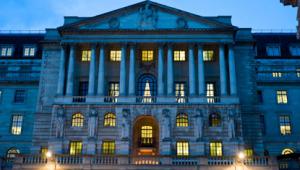The Bank of England announced today that it would pump a further £50bn into the economy through quantitative easing to counter sluggish growth.
Under quantitative easing, the central bank increases the supply of money by buying assets such as government bonds from banks. The programme, which began in 2009, wasincreased by £75bn to £275bn last October. The latest announcement brings the total to £325bn.
The Bank’s Monetary Policy Committee judged that weak growth meant that further monetary stimulus was also necessary to stop inflation, currently 4.2%, falling below the 2% target in the medium term. The most recent UK Gross Domestic Product figures show that the economy shrank by 0.2% in the last quarter.
The Centre for Economics and Business Research said that the bank was hoping that buying up assets, which would take place over the next three months, would provide extra cash for banks to lend.
However, economist Daniel Solomon said that the plan would only be effective if private investors use their newfound liquidity to increase lending.
‘In these uncertain times, there is a tendency for risk-averse private investors to hoard money, making QE less effective. This latest round of accommodative monetary policy may have less of an impact than Bank of England governor Sir Mervyn King would like,’ he said.
The CBI also warned that, even with extra asset purchases, the direct stimulus to short-term growth was likely to be limited.
Ian McCafferty, chief economic advisor at the CBI, said: ‘The bank has been signalling that a further extension of the asset purchase programme was likely this month. Even though there are tentative signs that the economy is stabilising, the outlook is still highly uncertain.’
The MPC also voted to maintain the base interest rate at 0.5%, which has been unchanged since March 2009.




















